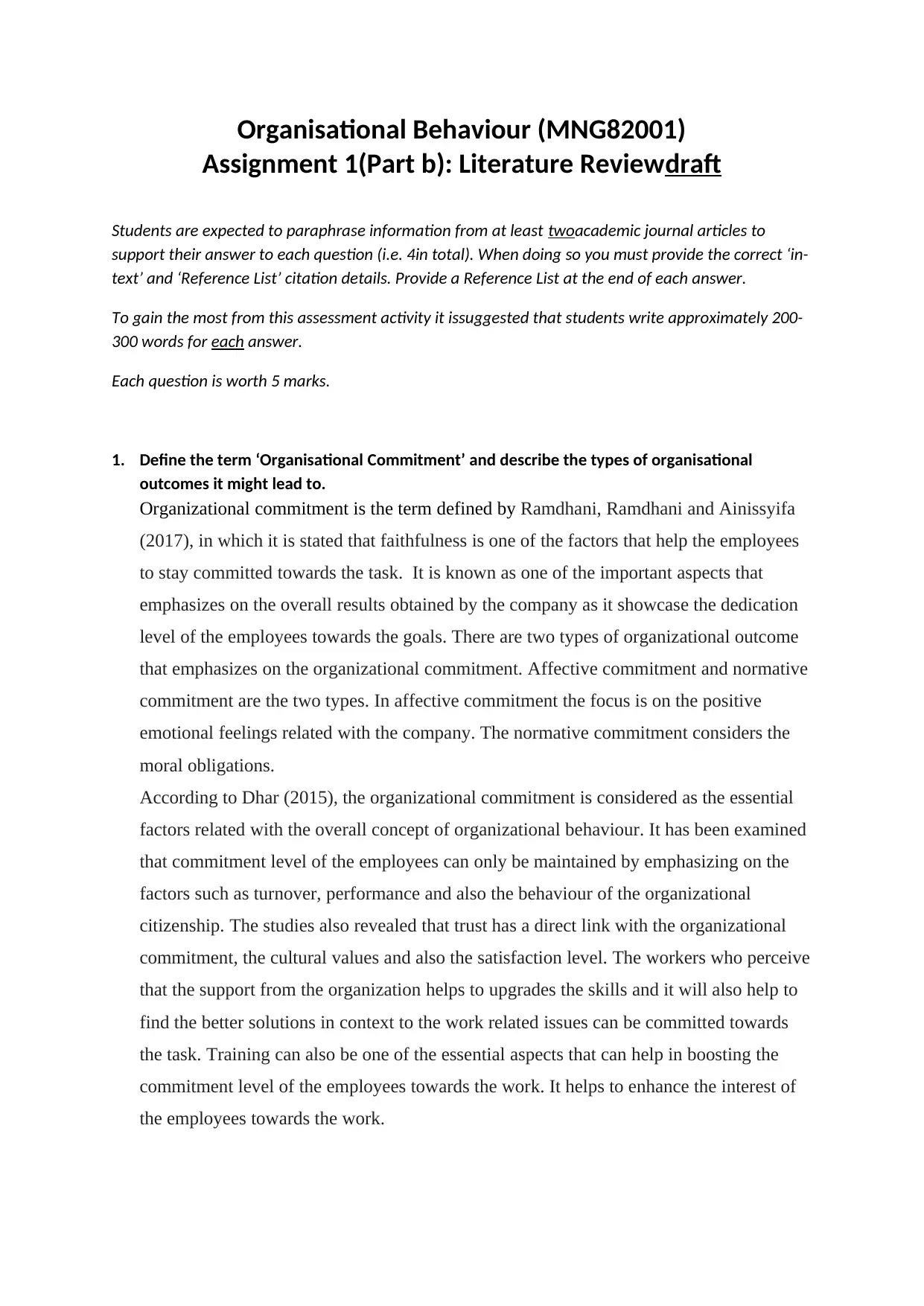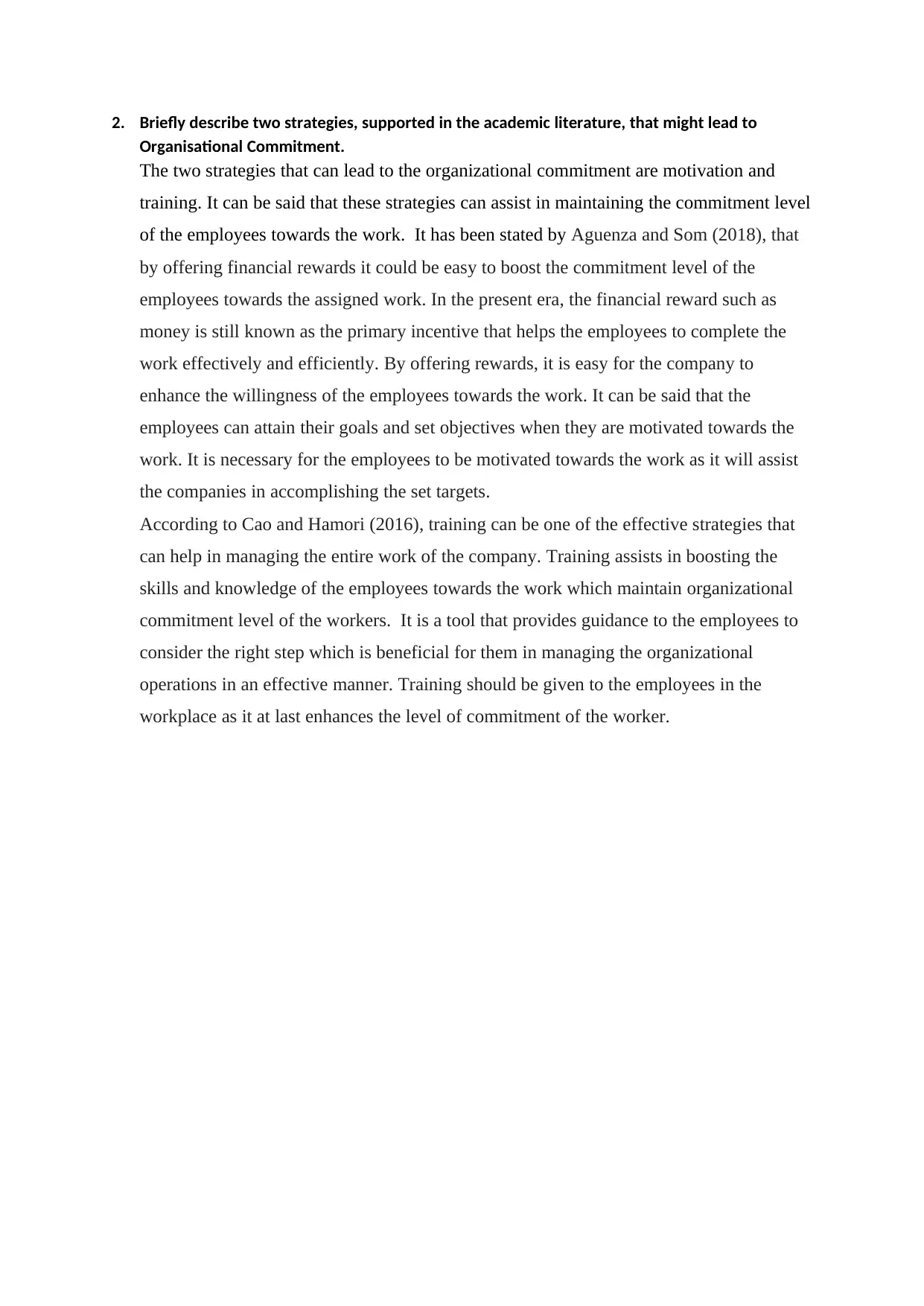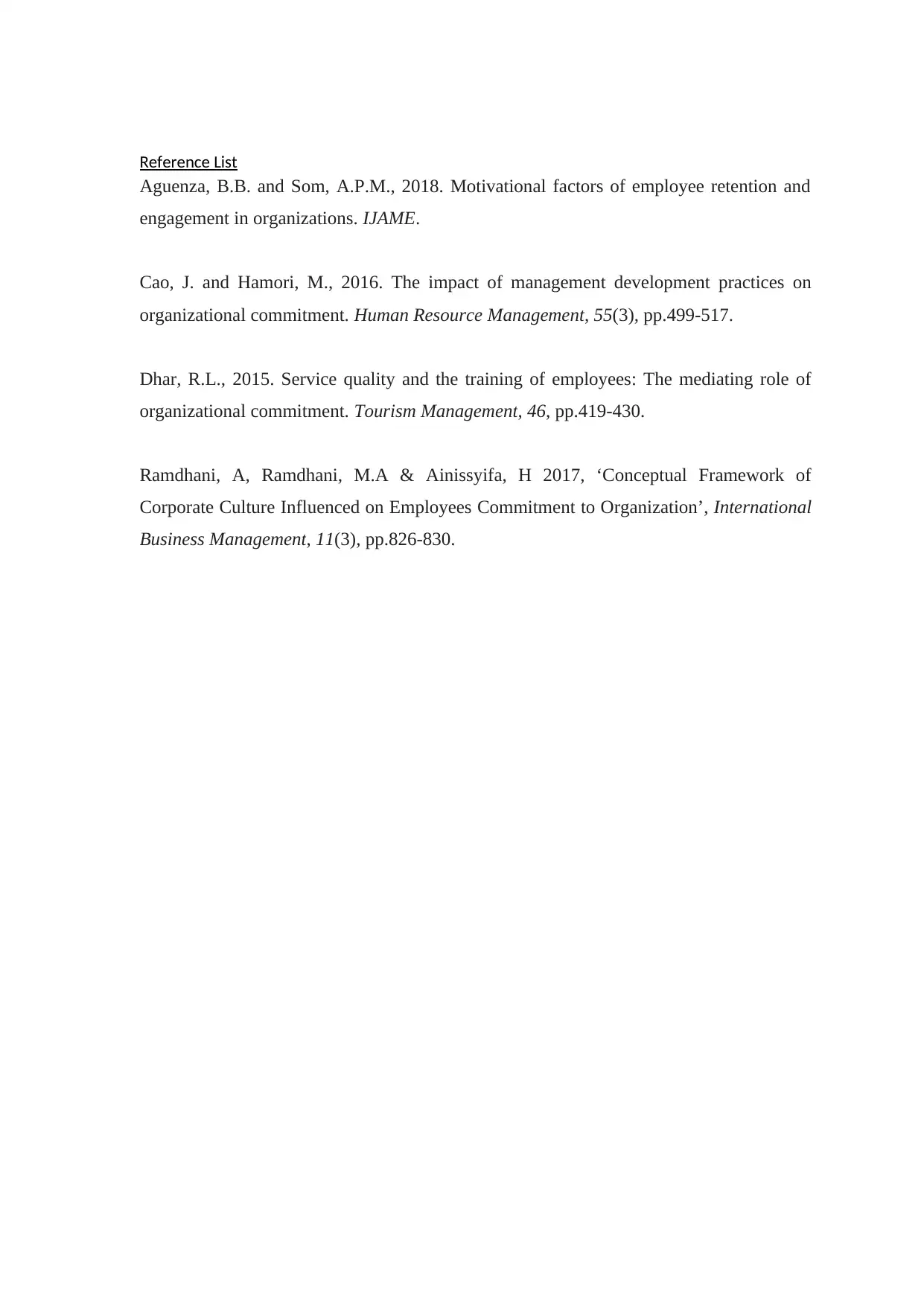MNG82001: Organisational Behaviour Assignment 1 (Part B) Draft
VerifiedAdded on 2023/01/10
|3
|809
|53
Homework Assignment
AI Summary
This assignment, a literature review draft for Organisational Behaviour (MNG82001), explores the concept of organisational commitment. The assignment defines organisational commitment, differentiating between affective and normative commitment, and discusses its impact on outcomes. It also examines strategies such as motivation and training, supported by academic research, that can foster employee commitment. The student provides citations and references to support their arguments, adhering to the assignment's word count and formatting guidelines. The assignment aims to provide a foundation for a more comprehensive literature review.

Organisational Behaviour (MNG82001)
Assignment 1(Part b): Literature Reviewdraft
Students are expected to paraphrase information from at least twoacademic journal articles to
support their answer to each question (i.e. 4in total). When doing so you must provide the correct ‘in-
text’ and ‘Reference List’ citation details. Provide a Reference List at the end of each answer.
To gain the most from this assessment activity it issuggested that students write approximately 200-
300 words for each answer.
Each question is worth 5 marks.
1. Define the term ‘Organisational Commitment’ and describe the types of organisational
outcomes it might lead to.
Organizational commitment is the term defined by Ramdhani, Ramdhani and Ainissyifa
(2017), in which it is stated that faithfulness is one of the factors that help the employees
to stay committed towards the task. It is known as one of the important aspects that
emphasizes on the overall results obtained by the company as it showcase the dedication
level of the employees towards the goals. There are two types of organizational outcome
that emphasizes on the organizational commitment. Affective commitment and normative
commitment are the two types. In affective commitment the focus is on the positive
emotional feelings related with the company. The normative commitment considers the
moral obligations.
According to Dhar (2015), the organizational commitment is considered as the essential
factors related with the overall concept of organizational behaviour. It has been examined
that commitment level of the employees can only be maintained by emphasizing on the
factors such as turnover, performance and also the behaviour of the organizational
citizenship. The studies also revealed that trust has a direct link with the organizational
commitment, the cultural values and also the satisfaction level. The workers who perceive
that the support from the organization helps to upgrades the skills and it will also help to
find the better solutions in context to the work related issues can be committed towards
the task. Training can also be one of the essential aspects that can help in boosting the
commitment level of the employees towards the work. It helps to enhance the interest of
the employees towards the work.
Assignment 1(Part b): Literature Reviewdraft
Students are expected to paraphrase information from at least twoacademic journal articles to
support their answer to each question (i.e. 4in total). When doing so you must provide the correct ‘in-
text’ and ‘Reference List’ citation details. Provide a Reference List at the end of each answer.
To gain the most from this assessment activity it issuggested that students write approximately 200-
300 words for each answer.
Each question is worth 5 marks.
1. Define the term ‘Organisational Commitment’ and describe the types of organisational
outcomes it might lead to.
Organizational commitment is the term defined by Ramdhani, Ramdhani and Ainissyifa
(2017), in which it is stated that faithfulness is one of the factors that help the employees
to stay committed towards the task. It is known as one of the important aspects that
emphasizes on the overall results obtained by the company as it showcase the dedication
level of the employees towards the goals. There are two types of organizational outcome
that emphasizes on the organizational commitment. Affective commitment and normative
commitment are the two types. In affective commitment the focus is on the positive
emotional feelings related with the company. The normative commitment considers the
moral obligations.
According to Dhar (2015), the organizational commitment is considered as the essential
factors related with the overall concept of organizational behaviour. It has been examined
that commitment level of the employees can only be maintained by emphasizing on the
factors such as turnover, performance and also the behaviour of the organizational
citizenship. The studies also revealed that trust has a direct link with the organizational
commitment, the cultural values and also the satisfaction level. The workers who perceive
that the support from the organization helps to upgrades the skills and it will also help to
find the better solutions in context to the work related issues can be committed towards
the task. Training can also be one of the essential aspects that can help in boosting the
commitment level of the employees towards the work. It helps to enhance the interest of
the employees towards the work.
Paraphrase This Document
Need a fresh take? Get an instant paraphrase of this document with our AI Paraphraser

2. Briefly describe two strategies, supported in the academic literature, that might lead to
Organisational Commitment.
The two strategies that can lead to the organizational commitment are motivation and
training. It can be said that these strategies can assist in maintaining the commitment level
of the employees towards the work. It has been stated by Aguenza and Som (2018), that
by offering financial rewards it could be easy to boost the commitment level of the
employees towards the assigned work. In the present era, the financial reward such as
money is still known as the primary incentive that helps the employees to complete the
work effectively and efficiently. By offering rewards, it is easy for the company to
enhance the willingness of the employees towards the work. It can be said that the
employees can attain their goals and set objectives when they are motivated towards the
work. It is necessary for the employees to be motivated towards the work as it will assist
the companies in accomplishing the set targets.
According to Cao and Hamori (2016), training can be one of the effective strategies that
can help in managing the entire work of the company. Training assists in boosting the
skills and knowledge of the employees towards the work which maintain organizational
commitment level of the workers. It is a tool that provides guidance to the employees to
consider the right step which is beneficial for them in managing the organizational
operations in an effective manner. Training should be given to the employees in the
workplace as it at last enhances the level of commitment of the worker.
Organisational Commitment.
The two strategies that can lead to the organizational commitment are motivation and
training. It can be said that these strategies can assist in maintaining the commitment level
of the employees towards the work. It has been stated by Aguenza and Som (2018), that
by offering financial rewards it could be easy to boost the commitment level of the
employees towards the assigned work. In the present era, the financial reward such as
money is still known as the primary incentive that helps the employees to complete the
work effectively and efficiently. By offering rewards, it is easy for the company to
enhance the willingness of the employees towards the work. It can be said that the
employees can attain their goals and set objectives when they are motivated towards the
work. It is necessary for the employees to be motivated towards the work as it will assist
the companies in accomplishing the set targets.
According to Cao and Hamori (2016), training can be one of the effective strategies that
can help in managing the entire work of the company. Training assists in boosting the
skills and knowledge of the employees towards the work which maintain organizational
commitment level of the workers. It is a tool that provides guidance to the employees to
consider the right step which is beneficial for them in managing the organizational
operations in an effective manner. Training should be given to the employees in the
workplace as it at last enhances the level of commitment of the worker.

Reference List
Aguenza, B.B. and Som, A.P.M., 2018. Motivational factors of employee retention and
engagement in organizations. IJAME.
Cao, J. and Hamori, M., 2016. The impact of management development practices on
organizational commitment. Human Resource Management, 55(3), pp.499-517.
Dhar, R.L., 2015. Service quality and the training of employees: The mediating role of
organizational commitment. Tourism Management, 46, pp.419-430.
Ramdhani, A, Ramdhani, M.A & Ainissyifa, H 2017, ‘Conceptual Framework of
Corporate Culture Influenced on Employees Commitment to Organization’, International
Business Management, 11(3), pp.826-830.
Aguenza, B.B. and Som, A.P.M., 2018. Motivational factors of employee retention and
engagement in organizations. IJAME.
Cao, J. and Hamori, M., 2016. The impact of management development practices on
organizational commitment. Human Resource Management, 55(3), pp.499-517.
Dhar, R.L., 2015. Service quality and the training of employees: The mediating role of
organizational commitment. Tourism Management, 46, pp.419-430.
Ramdhani, A, Ramdhani, M.A & Ainissyifa, H 2017, ‘Conceptual Framework of
Corporate Culture Influenced on Employees Commitment to Organization’, International
Business Management, 11(3), pp.826-830.
⊘ This is a preview!⊘
Do you want full access?
Subscribe today to unlock all pages.

Trusted by 1+ million students worldwide
1 out of 3
Related Documents
Your All-in-One AI-Powered Toolkit for Academic Success.
+13062052269
info@desklib.com
Available 24*7 on WhatsApp / Email
![[object Object]](/_next/static/media/star-bottom.7253800d.svg)
Unlock your academic potential
Copyright © 2020–2025 A2Z Services. All Rights Reserved. Developed and managed by ZUCOL.




